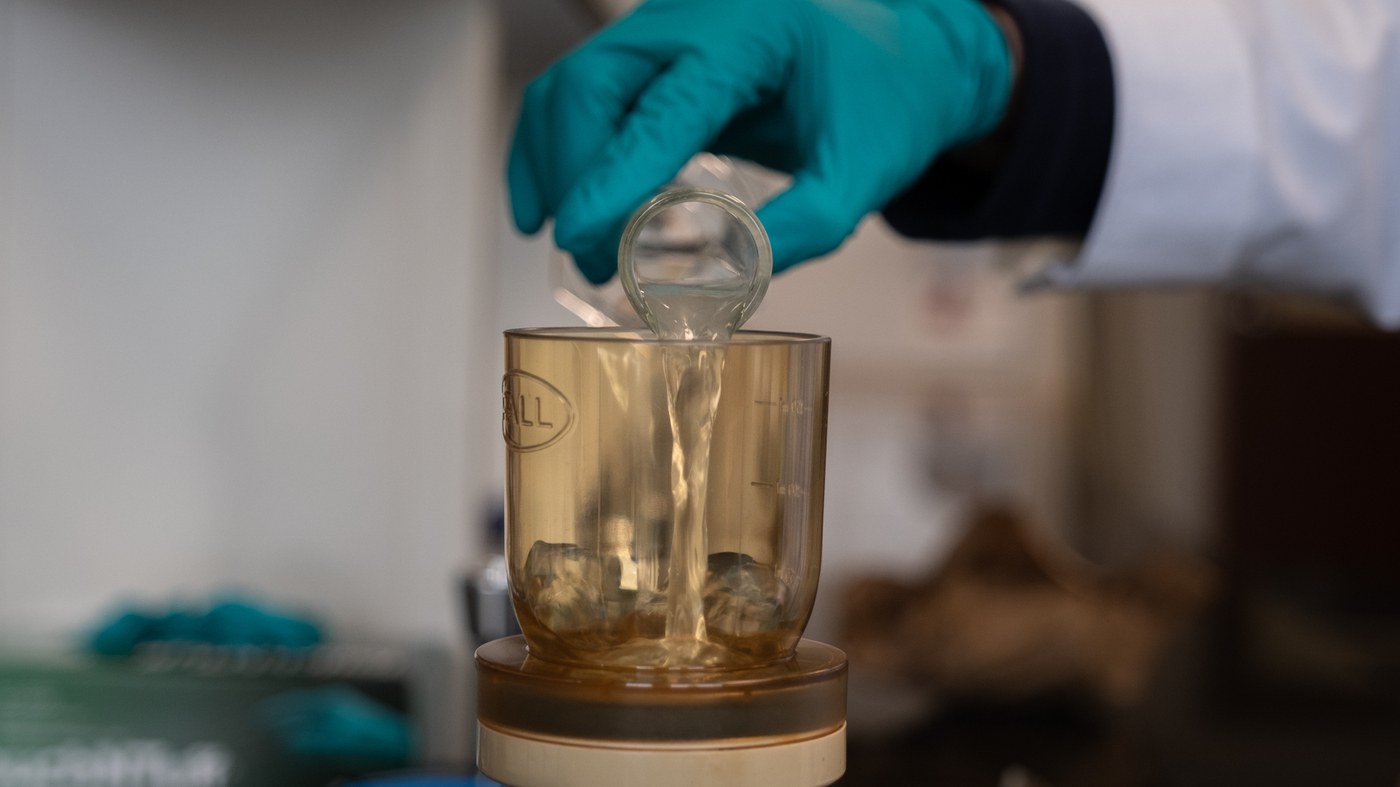
A sewage remedy plant in Norfolk, Va., is likely one of the websites the place staff acquire wastewater samples to check for COVID traits within the close by group.
Meredith Rizzo/NPR
conceal caption
toggle caption
Meredith Rizzo/NPR

A sewage remedy plant in Norfolk, Va., is likely one of the websites the place staff acquire wastewater samples to check for COVID traits within the close by group.
Meredith Rizzo/NPR
VIRGINIA BEACH, Va. – One of the best time of day to gather a wastewater pattern is within the morning. That is based on Raul Gonzalez, an environmental scientist who’s an knowledgeable on how individuals’s hygiene habits intersect with the move of sewage.
Gonzalez runs the wastewater surveillance program on the Hampton Roads Sanitation District, a Virginia Seashore, Va., sewage remedy operation that processes waste for 20% of the state’s inhabitants. He and his group had been early adopters of wastewater surveillance – a means of monitoring the focus of viruses, micro organism and infectious ailments in sewage to look at for infectious illness outbreaks.
Since March 2020 – months earlier than the Facilities for Illness Management and Prevention launched a nationwide initiative – Gonzalez and his colleagues have been monitoring COVID ranges within the sewage that comes by way of their vegetation.

Wastewater — from close by houses, companies, bathrooms and sinks — finally ends up on the Virginia Initiative Plant in Norfolk, Va., the place it will get routed by way of varied levels of remedy earlier than being launched into the Chesapeake Bay.
Meredith Rizzo/NPR
conceal caption
toggle caption
Meredith Rizzo/NPR

Wastewater — from close by houses, companies, bathrooms and sinks — finally ends up on the Virginia Initiative Plant in Norfolk, Va., the place it will get routed by way of varied levels of remedy earlier than being launched into the Chesapeake Bay.
Meredith Rizzo/NPR

Notes
Wastewater oxidizes in one of many tanks on the remedy facility.
Wastewater information is a helpful complement to the standard metrics of circumstances, hospitalizations and deaths, well being consultants say. The info do not rely on individuals looking for out testing or labs reporting outcomes. As an alternative, it depends on individuals’s day by day habits, and the truth that individuals carrying the virus will shed it once they poop. It identifies broad traits rapidly, and can be utilized to check for different pathogens like flu, polio, mpox and antibiotic-resistant micro organism.
How wastewater surveillance occurs
How does a bit of the virus that causes COVID from somebody’s intestine move from their rest room to the sewage remedy plant — and find yourself as an information level on a COVID dashboard? On the Hampton Roads Sanitation District, it takes two days and the labor of many individuals. All of it begins with a pattern gathered early within the day, to catch individuals’s morning poops.

Marcos Davila-Banrey and Jon Nelson put together to seize a wastewater pattern for the Hampton Roads Sanitation District COVID surveillance program.
Meredith Rizzo/NPR
conceal caption
toggle caption
Meredith Rizzo/NPR

Marcos Davila-Banrey and Jon Nelson put together to seize a wastewater pattern for the Hampton Roads Sanitation District COVID surveillance program.
Meredith Rizzo/NPR

Nelson lifts a sterile plastic bottle on the finish of a pole stuffed with murky wastewater. The water pattern he retrieves will develop into helpful info on the degrees of COVID within the close by group.
Meredith Rizzo/NPR
conceal caption
toggle caption
Meredith Rizzo/NPR
On a current, grey day at a remedy plant in Norfolk, Gonzalez’s colleague Jon Nelson stood over a small steel hatch that opened onto a pipe of incoming sewage. He put a sterile plastic bottle on the finish of a protracted pole extra sometimes used to carry a paint curler, and lowered it about 18 toes into the river of wastewater coming from the area’s houses, campuses and companies.
By the point it will get to the plant, sewage smells just a bit sulfurous and it isn’t brown, however a murky grey. “It seems to be nothing like what you see in the bathroom,” says Joshua Coyle, an operations lead on the plant – within the journey by way of the pipes, “[the fecal matter] all dissolves and breaks down.”
As soon as the wastewater is bottled, it turns into a valuable pattern. It is chilled in a cooler of ice, to maintain it contemporary for the 20-minute drive to the labs on the sewage utility’s headquarters.
It is a ritual the group has carried out each week for the previous three years – not simply at this one plant however on the eight they handle, protecting 5,000 sq. miles in southeast Virginia.

Raul Gonzalez, at a Hampton Highway Sanitation District lab in Virginia Seashore, Va. He leads the district’s wastewater surveillance program which started monitoring COVID ranges in March 2020.
Meredith Rizzo/NPR
conceal caption
toggle caption
Meredith Rizzo/NPR
This system took loads of “blood, sweat and tears” to face up, Gonzalez says, recalling the early, unsure days of the COVID pandemic and the experimentation it took to seek out dependable methods to measure COVID within the wastewater. Now, they have their course of dialed in.
Cleansing up sewage samples again within the lab
On the sewage utility headquarters, the pattern passes by way of three adjoining laboratories and several other workers to get the virus filtered out of the sewage water, cleaned after which counted.

Notes
When the wastewater arrives on the lab, acid is added to positively cost virus particles within the pattern.

Kat Yetka (left) pours the wastewater pattern over a filter (proper), negatively-charged to raised seize COVID virus particles, at a Hampton Highway Sanitation District lab in Virginia Seashore, Va.
Meredith Rizzo/NPR
conceal caption
toggle caption
Meredith Rizzo/NPR
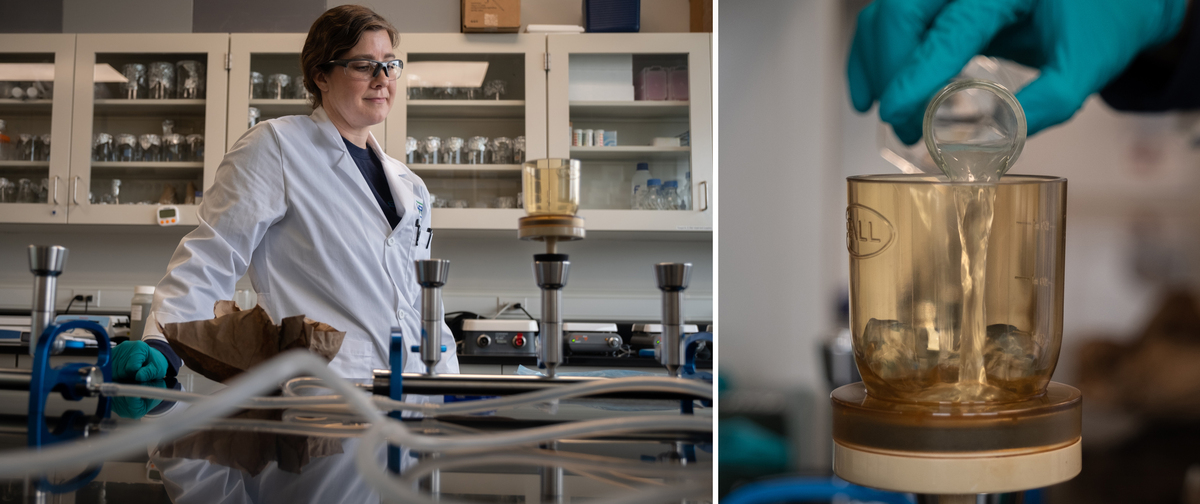
Kat Yetka (left) pours the wastewater pattern over a filter (proper), negatively-charged to raised seize COVID virus particles, at a Hampton Highway Sanitation District lab in Virginia Seashore, Va.
Meredith Rizzo/NPR
Step one is to move a number of the liquid from the bottle by way of a paper filter, which helps separate the virus from the sludge within the water. Workers scientist Kat Yetka provides acid to the pattern to positively cost the virus particles, in order that they’re extra prone to follow the negatively-charged filter. It takes only a few minutes. The pattern has gone from a one-liter bottle of liquid, to a small paper filter, in regards to the width of an Oreo cookie. Yetka folds it with forceps and sticks it in a take a look at tube.
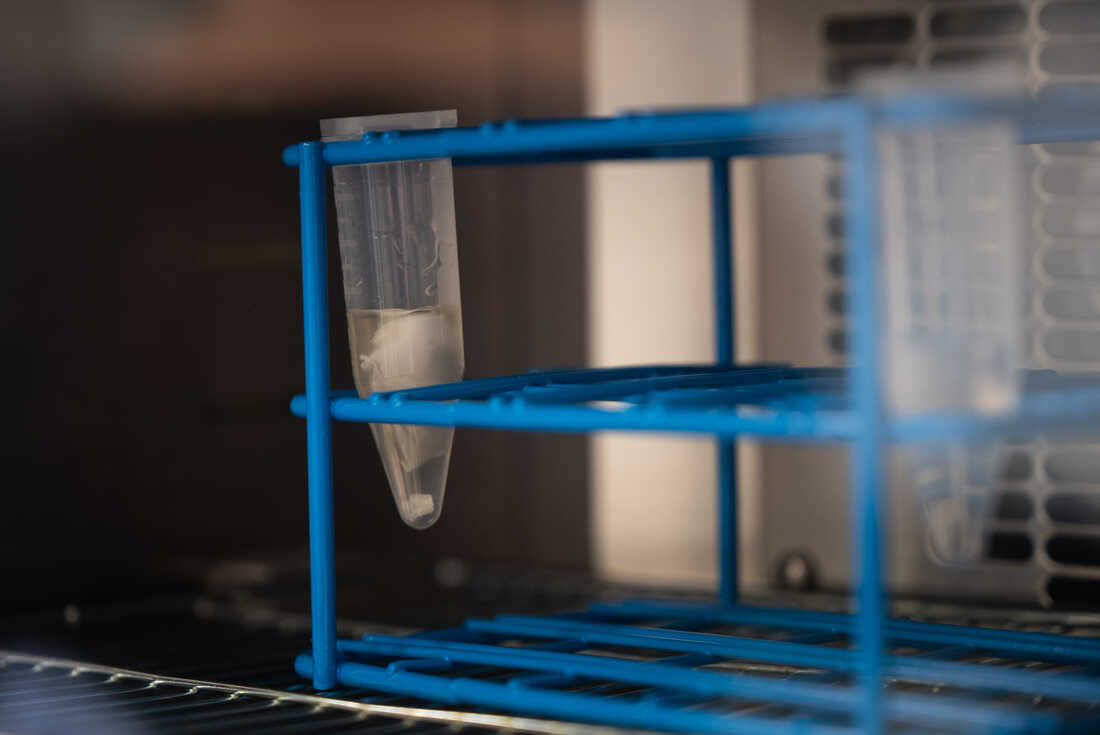
The filter soaks in a small vial as a part of the method.
Meredith Rizzo/NPR
conceal caption
toggle caption
Meredith Rizzo/NPR

The filter soaks in a small vial as a part of the method.
Meredith Rizzo/NPR
That filter will get bathed in chemical substances to launch the viral RNA from cells within the pattern, after which to scrub away poop and different detritus. “[We’re washing] every thing from solids to natural supplies to salts out of the pattern,” Gonzalez says, “We’re attempting to scrub up every thing however the targets we’re in search of.”
As soon as the pattern is as clear as it may be — it is time to begin quantifying how a lot virus the researchers have collected.
Hannah Thompson, a microbiologist on the lab, provides a fluorescent dye to the pattern, which glows when it attaches to the COVID virus. She takes a little bit of the handled liquid — in regards to the dimension of a raindrop — and breaks it down into many smaller droplets. It is the ratio – of droplets which have COVID in them, versus those who do not – that can function the idea for determining how a lot virus is within the whole pattern.
She then places the droplets right into a machine that makes copies of the virus’ genetic code “by way of 40 cycles of heating and cooling, heating and cooling” she says, so the degrees might be excessive sufficient to measure.
“By the tip, we’ll have billions of copies,” Thompson says. The method takes a number of hours, in order that they set it to run in a single day.
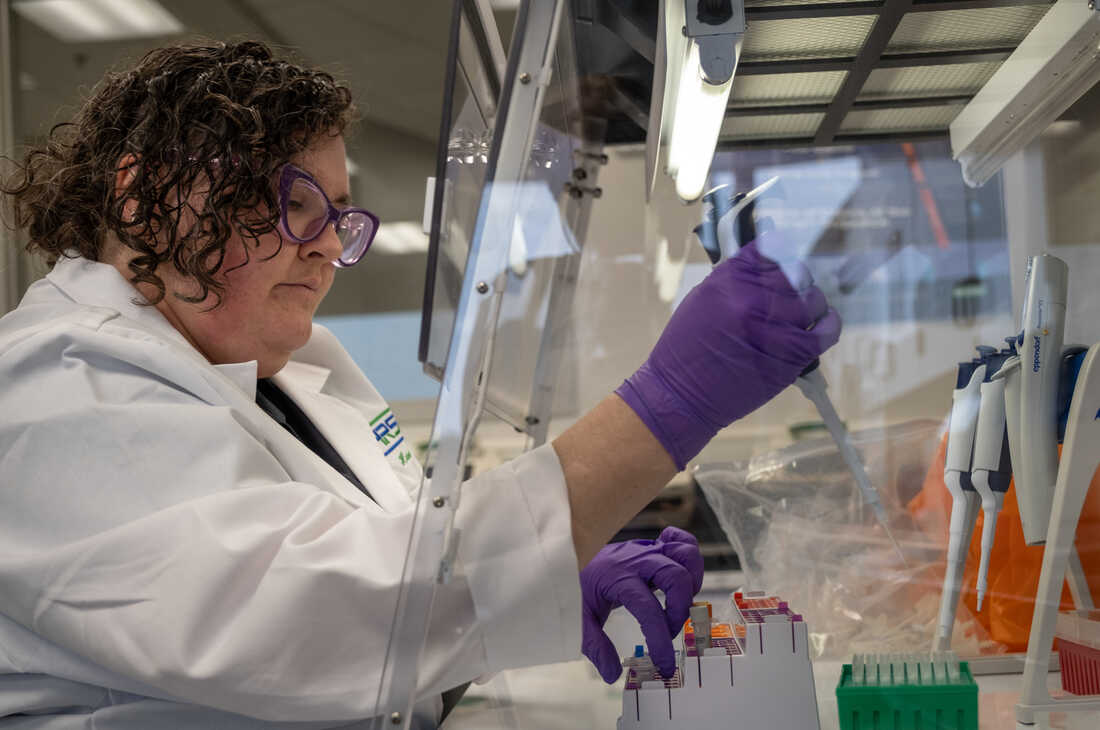
Hannah Thompson mixes probes and primers that she provides to the pattern to assist establish COVID within the water. The aim is to run these by way of a machine that can amplify any COVID within the liquid.
Meredith Rizzo/NPR
conceal caption
toggle caption
Meredith Rizzo/NPR
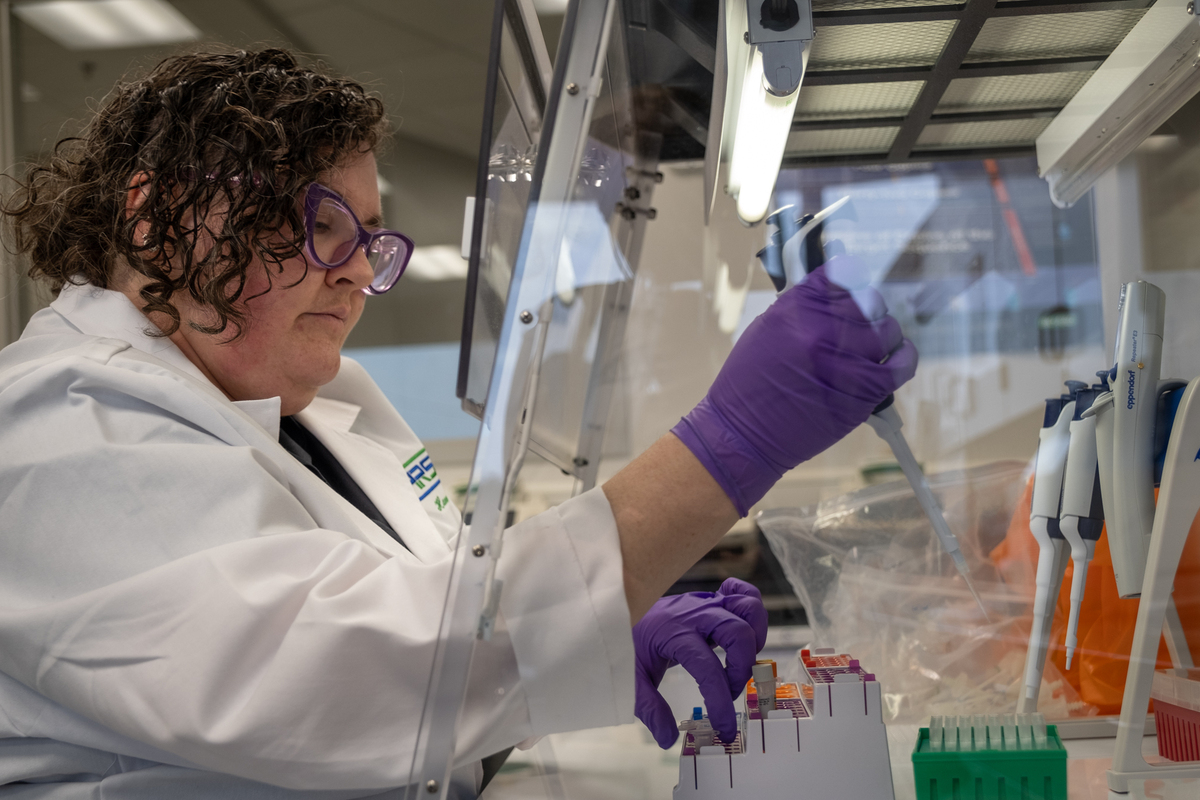
Hannah Thompson mixes probes and primers that she provides to the pattern to assist establish COVID within the water. The aim is to run these by way of a machine that can amplify any COVID within the liquid.
Meredith Rizzo/NPR
Right here in Virginia Seashore, processing a single wastewater pattern takes two days and a number of expert staff. This is not the method all over the place – some sewage vegetation acquire samples that they then ship off to state well being departments or the CDC’s federal contractors to course of.
And plenty of vegetation do not take part in any respect – it is fully voluntary. The CDC says that nationally, the wastewater surveillance program they coordinate covers round 40% of the U.S. inhabitants.
Along with analyzing their very own wastewater, Gonzalez’s group additionally sends some samples to Virginia’s well being division and the CDC. Nonetheless, he says his group is continuous its personal efforts in-house as a result of it creates a constant file courting again to the beginning of the pandemic, and it is helpful for his or her native well being departments.
Early the following morning, Gonzalez is again on the lab with Hila Stephens, a molecular biologist, who runs the plate with the droplets by way of a machine to determine how a lot COVID was within the pattern.
“I am betting my cash on a development that is been going for awhile,” Stephens says, “So there will be some COVID within the water.” She is true. The quantity of COVID within the water that week in March is about the identical because it was the week earlier than.
The sewage information drives a public well being dashboard
The info will get shared on a public dashboard. Kyle Curtis, Gonzalez’s fellow environmental scientist on workers, runs the numbers by way of a pc script to visualise how the degrees are trending. Although the virus stage are excessive (as of this studying in March), hospitalizations and deaths are as little as they have been this complete pandemic.
“I feel we have a look at it with totally different eyes than we used to,” Curtis says. “In earlier waves, we did not know what the ceiling [of infections and serious illness] seemed like for the group.” Now, the broad stage of immunity from vaccinations and former infections signifies that excessive ranges of COVID do not essentially forecast many COVID deaths.
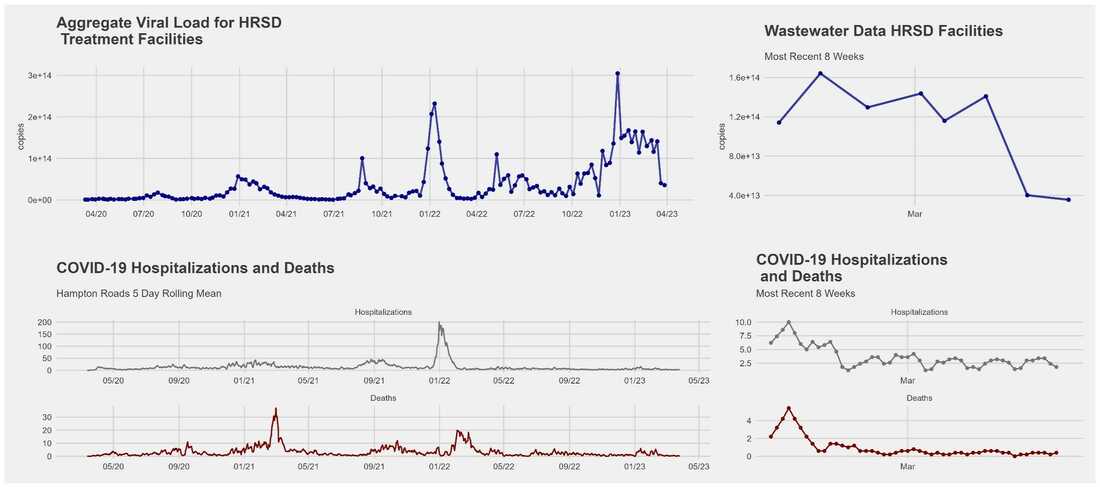
Gonzalez and his group use the surveillance information they acquire to trace total traits in COVID infections. The knowledge is made accessible on a public dashboard alongside hospitalizations and deaths with the intention to give a fuller image of the well being of the group.
HRSD/Screenshot by NPR
conceal caption
toggle caption
HRSD/Screenshot by NPR
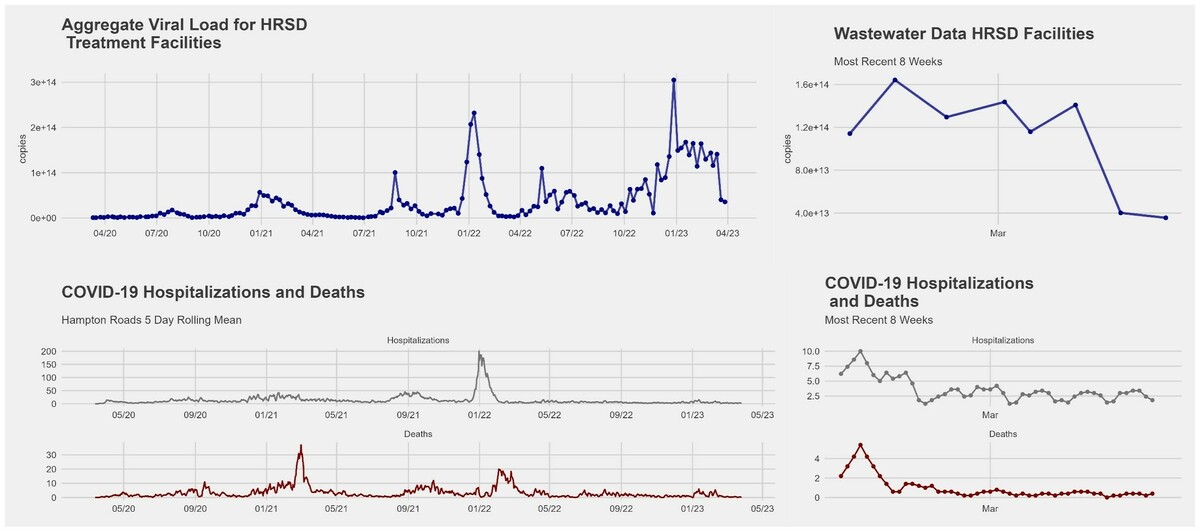
Gonzalez and his group use the surveillance information they acquire to trace total traits in COVID infections. The knowledge is made accessible on a public dashboard alongside hospitalizations and deaths with the intention to give a fuller image of the well being of the group.
HRSD/Screenshot by NPR
Nonetheless, public well being officers say these traits are necessary to trace.
“None of those single information factors are good,” says Dr. Caitlin Pedati, head of the Virginia Seashore Division of Public Well being. “But when I have a look at my wastewater traits along with hospitalization information and what is going on on in nursing houses, amongst high-risk services and populations, that is going to present me an honest sense of whether or not exercise goes up, happening or staying the identical.”
That in flip could possibly be used to assist her decide the place and when to supply COVID testing or vaccine clinics for individuals at larger threat from COVID.
Wastewater surveillance bought loads of consideration and funding throughout COVID. Many public well being officers hope that is simply the beginning. “We’re within the means of increasing [wastewater surveillance] to a complete suite of different pathogens, from influenza and RSV to norovirus and E. coli,” says Amy Kirby, who leads the CDC’s nationwide wastewater surveillance program.
She envisions a future the place the information function an early warning for public well being officers, and as a “well being climate report” for communities, the place individuals might test a dashboard displaying pathogen traits of their space, and use it to resolve whether or not to put on a masks, or take precautions whereas touring, or to take further care cooking their meals or washing their palms.
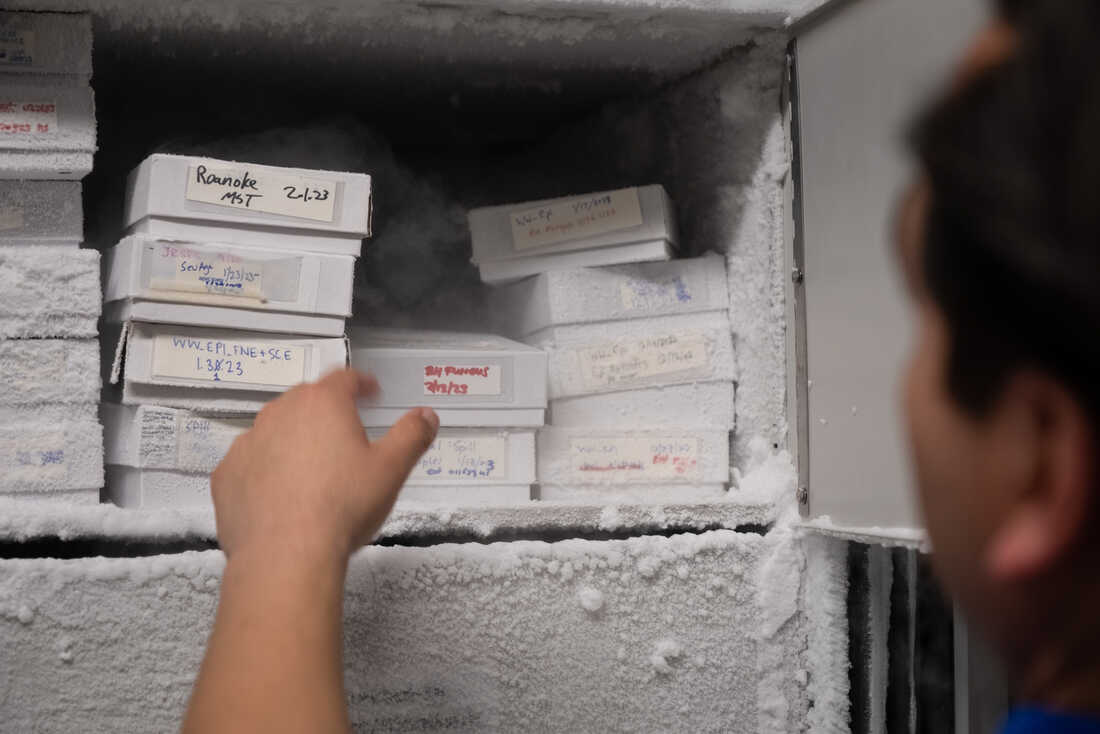
Gonzalez’s group shops a small portion of their wastewater samples within the freezer. Many public well being officers hope that the eye and funding for COVID surveillance finally extends to different pathogens too, like monitoring RSV or norovirus infections.
Meredith Rizzo/NPR
conceal caption
toggle caption
Meredith Rizzo/NPR

Gonzalez’s group shops a small portion of their wastewater samples within the freezer. Many public well being officers hope that the eye and funding for COVID surveillance finally extends to different pathogens too, like monitoring RSV or norovirus infections.
Meredith Rizzo/NPR
However Gonzalez says it takes loads of time and assets to maintain it going. He is a part of a committee on the Nationwide Academies of Sciences, Engineering, and Medication urging extra funding for the nationwide program. Thus far, the federal authorities has spent $300 million on wastewater surveillance, and is dedicated to spending one other $320 million to increase this system by way of 2025.
The system might function an early warning sign in a future pandemic. “We have invested lots to construct this technique, and it could be troublesome to close it down and begin it up once more,” Kirby says, “It is way more cost-efficient to maintain it working.” However, she says, it requires continued funding to make that actual.
Pictures and visuals manufacturing by Meredith Rizzo. Modifying by Scott Hensley.

